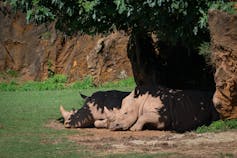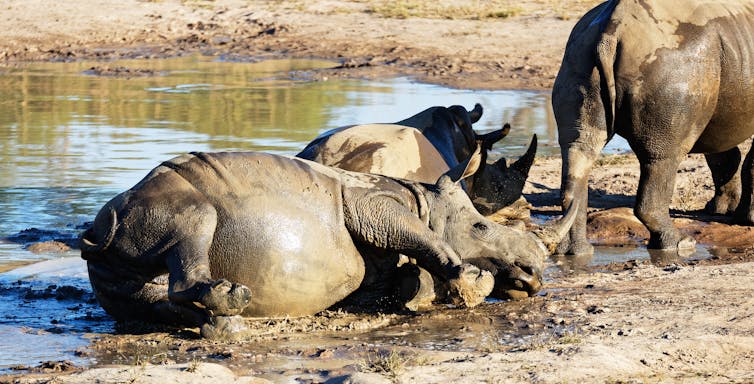By Timothy Randhir
Southern Africa is home to 22,137 of the world’s 23,432 white and black African rhinos. But they’re facing grave threats because of a warming planet. Now, the first study of how climate change affects rhinos in southern Africa has found that they will cease to exist in the region’s national parks by 2085 if the world takes the worst-case scenario climate change pathway. Timothy Randhir, who has been an ecological economist for 47 years, explains what governments and parks can do to prevent this from happening.
Why are rhinos in danger of being wiped out?
Rhinos cannot sweat. If they want to cool their large bodies down in the heat, they need to consume a lot of water. They also rely on wallowing in water holes and resting in the shade. As Earth heats up, rhinos will only survive if they have more opportunities to cool down.
How did you calculate that rhinos will not survive the worst scenario?
We looked back in history to see how rhinos lived in southern Africa, and in one park in Kenya. We looked at the temperature and rainfall averages in each of the best locations for rhinos, and then we mapped out the extremes. This defined the climatic domain and gave us a macroecological perspective (where we do not look at one specific site but look at the larger picture of how temperature and rain influence the behaviour of rhinos).
Our conclusion was that if the world enters the 8.5 Representative Concentration Pathway, there is zero probability of rhinos surviving in southern Africa.
Is there a Plan B to avoid the worst for rhinos?
Yes. Our view is that governments and societies should start planning immediately to ward off the worst-case scenario. They have to actively start adding some resilience into the system.
In 2085, it is likely that the national parks will still exist. But the parks will need to start now to be sure that they’ve built in many new water sources so that the rhinos can cool off at much more frequent intervals.

The parks will also need to establish undisturbed tree cover: large patches of trees with no moving traffic or crop harvesting nearby. Those are important cooling off areas. The national parks must add patches of tree cover that are deliberately planned so that in the rhinos’ home range, they do not need to walk further and further to find shade to cool down in.
For rhinos to survive this climate change scenario, corridors will also need to be set up for rhinos to move between parks. Human settlements around national parks are becoming a huge stressor for rhinos because of poaching and also because they reduce the freedom of movement for rhinos. This will be very challenging for the parks and they must start planning their landscapes now.
How much will all this cost?
The costs will be a huge problem. Most parks are already stressed for funding. Parks have been trying to be creative in generating funds through eco-tourism and strategic elements of trophy hunting, but they have to be careful because some of the revenue-generating elements can add more stress to the system.
Read more: Africa’s mammals may not be able to keep up with the pace of climate change
This study is a call for governments and people to protect and invest in these national parks and not just use them as an economic activity. One of the ideas is that when you protect a species like rhinos, elephants and gorillas, the investment you make in that species will help multiple species. The whole system will be protected because of that.
Until recently, our mindset about rhinos was about how they benefit us by bringing in revenues. That mindset has to change. We have to start looking at rhinos as an essential part of an ecosystem that is providing services to society. Having an ecosystem mindset in how we value things becomes important for our survival.
2085 isn’t far away. Could it really be over for rhinos by then?
In my work on watershed management, ecohydrology, complex systems, water resources, water quality, ecological economics and sustainability, I have mapped such scenarios all over the world. Researcher Hlelowenkhosi S. Mamba and I investigated what would happen if conditions in southern Africa reached those mapped by the Intergovernmental Panel on Climate Change’s Representative Concentration Pathways. These pathways are the global standard for predicting how the climate will change based on the actions of humans. We chose to map the future of rhinos based on the 4.5 and 8.5 Representative Concentration Pathways.
The 4.5 Representative Concentration Pathway simply means that the amount of carbon dioxide in the atmosphere will rise from 410 parts per million (ppm) now to 650ppm by 2100. This will warm the climate on the planet by an average of 2.4°C (between 1.7 and 3.2 degrees celsius) by 2100. But Earth will only get onto this pathway if we manage to cut methane gas and carbon dioxide emissions. This will only happen if methane gas emissions stop increasing by 2050 and we also manage to reduce the amount of carbon dioxide we pump into the atmosphere by 2045. By 2100, carbon dioxide emissions would also need to drop by half the level reached in 2050. Southern Africa’s rhinos can survive this, although many other plants and animals cannot.
The 8.5 Representative Concentration Pathway is the worst-case scenario that we can currently predict. In this scenario, Earth’s population will increase dramatically and we will continue to burn as much coal as we do now. We will fail to reduce greenhouse gases and global warming will continue to increase this century. This will deliver a temperature increase in the world of 4.3°C by 2100.





